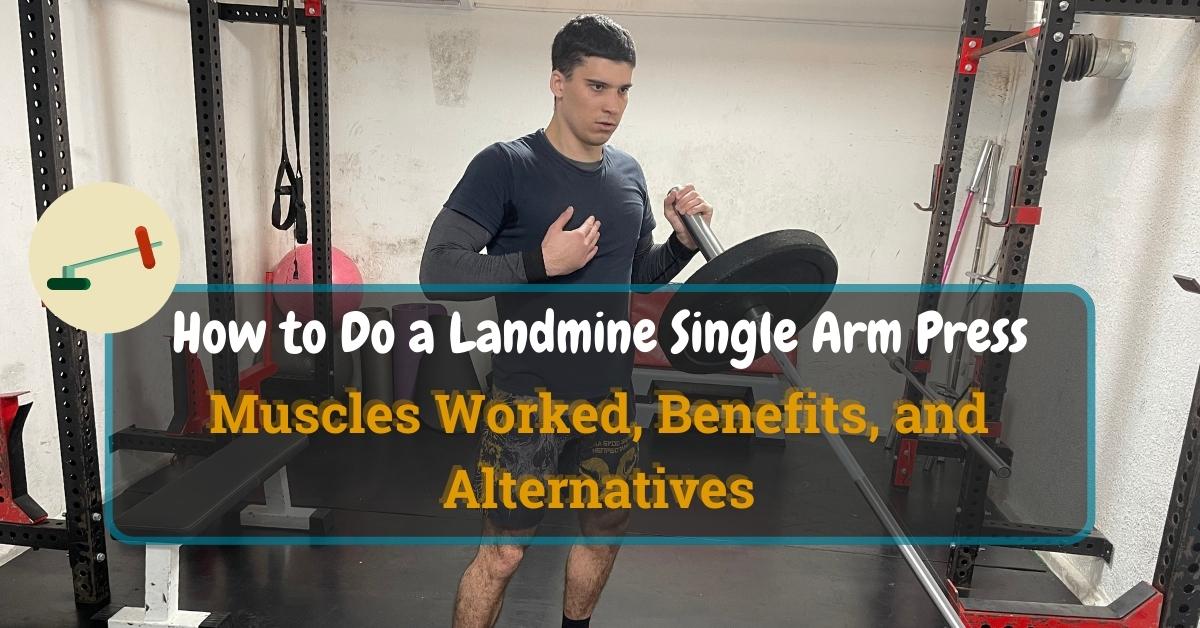The landmine single arm press is a dynamic exercise that blends strength, stability, and functional movement into one powerful movement. Based on my experience with numerous fitness clients, whether you’re a bodybuilding enthusiast or just looking to enhance your fitness regimen, this exercise is a game-changer.
Table of Contents
ToggleAlso, the landmine single arm press is a compound exercise targeting multiple muscle groups and joints at once, making it excellent for athletes and functional training enthusiasts.
In this article, you will learn:
- A detailed, step-by-step guide to mastering the landmine single arm press.
- The specific muscles targeted and the myriad benefits of this exercise.
- Variations and alternatives to diversify your workout routine.
Let’s start with a simple guide that will detail how to perform a single-arm landmine shoulder press without injuries while also thinking about maximizing workout performance.
Start Building Your Dream Body Today
Ready to elevate your fitness game without falling into the trap of dull, repetitive routines that just don’t deliver? Imagine sculpting your ideal physique and boosting your health, all while still enjoying life’s pleasures, like those irresistible weekend getaways and your aunt’s legendary cheesecake. With our online fitness and nutrition coaching service, you don’t have to compromise. Dive into a personalized fitness journey that blends perfectly with your lifestyle, not against it. Book your completely free discovery consultation today, and take the first step towards a transformation that doesn’t require giving up the joys of life.

“I was skeptical about online fitness coaching, but Functional Body Savage completely changed my perspective. Vanja and Radomir’s personalized approach and attention to detail have helped me achieve goals I never thought possible. I’m stronger, more confident, and grateful for their guidance.”
Emily Thompson, San Francisco, CA
Learn More About Our Online Coaching ServiceQuick Summary
- To perform the landmine single arm press, securely attach a barbell to a landmine attachment, stand with feet shoulder-width apart, grip the barbell at shoulder height, and press upwards while maintaining core stability.
- This exercise offers benefits like unilateral strength development, increased core engagement, improved shoulder stability, and reduced lower back strain, making it suitable for athletes and fitness enthusiasts.
- A study from PubMed Central highlights the effectiveness of cross-training in contralateral strength improvements, emphasizing the importance of balanced training.
- In my experience, it’s evident that the Landmine Single Arm Press is an essential exercise for those seeking comprehensive upper body development and functional strength.
How to Do a Landmine Single Arm Press: Step-By-Step Guide for a More Functional Bodybuilding Approach
Here is a simple guide for performing a unilateral landmine press to maximize performance and avoid injuries.
Step One — Set up the Barbell and the Landmine Attachment
Begin by securely attaching one end of a barbell to a landmine attachment. Proceed by loading the barbell with the appropriate weight. In my experience, start with the smallest plate until mastering the form and technique works the best.
If you don’t have a landmine attachment, the corner of a room can serve as a makeshift anchor. Ensure the barbell is stable before proceeding.

Pro Tip: Use a heavy-duty towel or mat under the barbell in a corner set up to protect the walls and equipment.
Step Two — Assume the Starting Position
Stand with your feet shoulder-width apart, facing the barbell. Grip the barbell with one hand, positioning it at shoulder height. Keep your elbow bent and close to your body to maintain tension in your upper arm. Make sure your glutes and core muscles are contracted during the whole movement for better stability and balance.
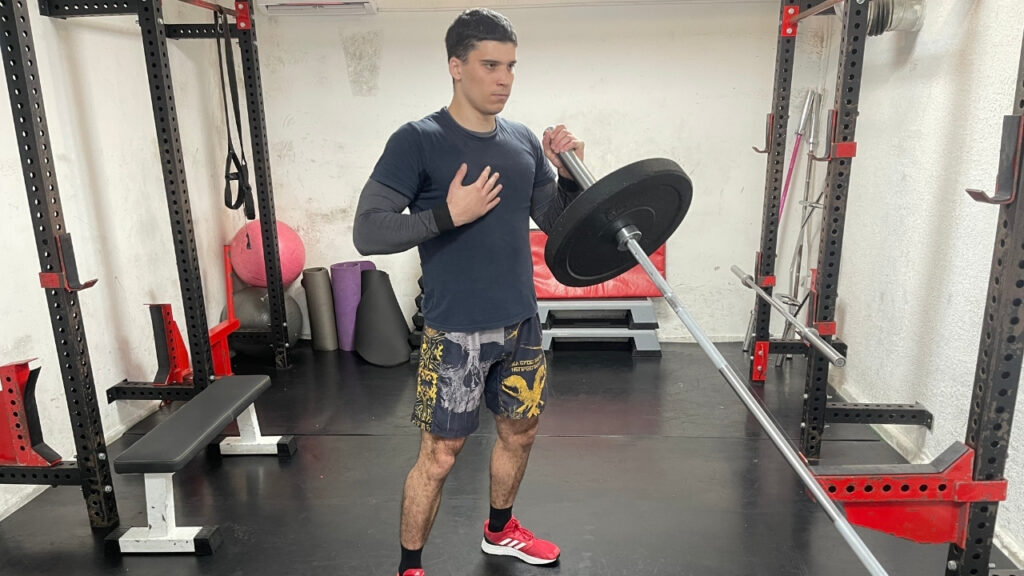
Pro Tip: Position your opposite arm out to the side or on your hip for added balance and to prevent torso rotation during the lift.
Step Three — Press the Barbell Overhead
Press the barbell upwards. Extend your arm fully, but avoid extreme overextension of your working elbow. Keep the movement controlled, aligning the barbell with your shoulder as you press. Hold the top position for a split second before proceeding with the following step.
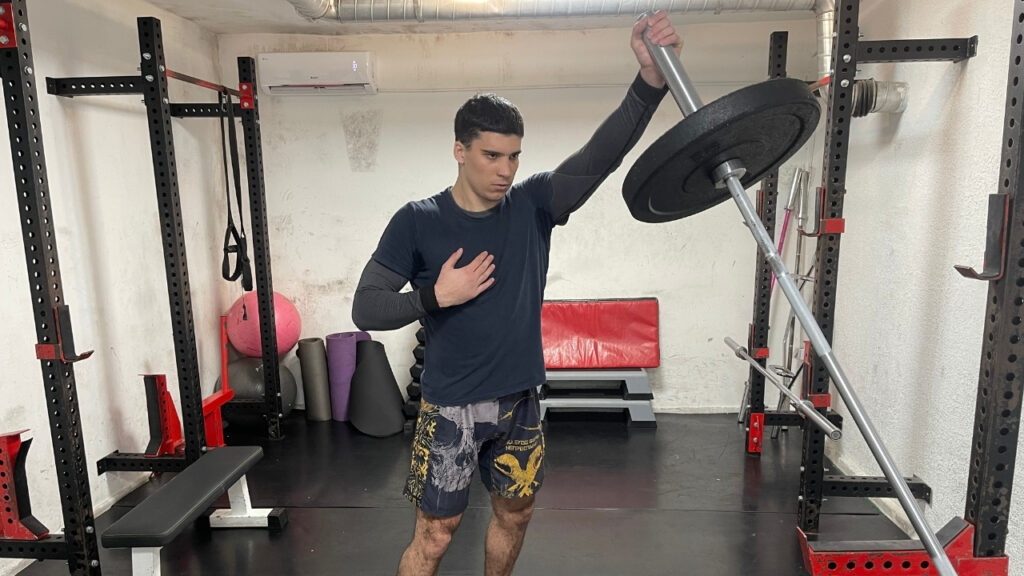
Pro Tip: Visualize pushing the floor away with your feet. This grounding technique helps engage the entire body, providing a stable base for the press.
Step Four — Return the Barbell to the Starting Position
Slowly lower the barbell back to the starting position. Keep the movement controlled and resist the urge to let gravity do the work. Repeat for the desired number of repetitions before switching arms.

Pro Tip: Inhale as you lower the barbell, using your breath to control the descent and maintain tension in your core. This will prepare the ground for forced exhalation during the following concentric phase, which will create intraabdominal pressure.
Landmine Single-Arm Press Muscles Worked
Based on my biomechanical analysis of the landmine single-arm press movement, primary muscles working include:
- Deltoids
- Pectoralis major
- Triceps brachii
Also, the secondary muscles working are:
- Abdominals and obliques
- Trapezius
- Rhomboids
- Rotator cuff muscles
Landmine Single Arm Press Benefits
The landmine single arm press offers a range of benefits that extend beyond muscle building, making it a valuable addition to any fitness routine.
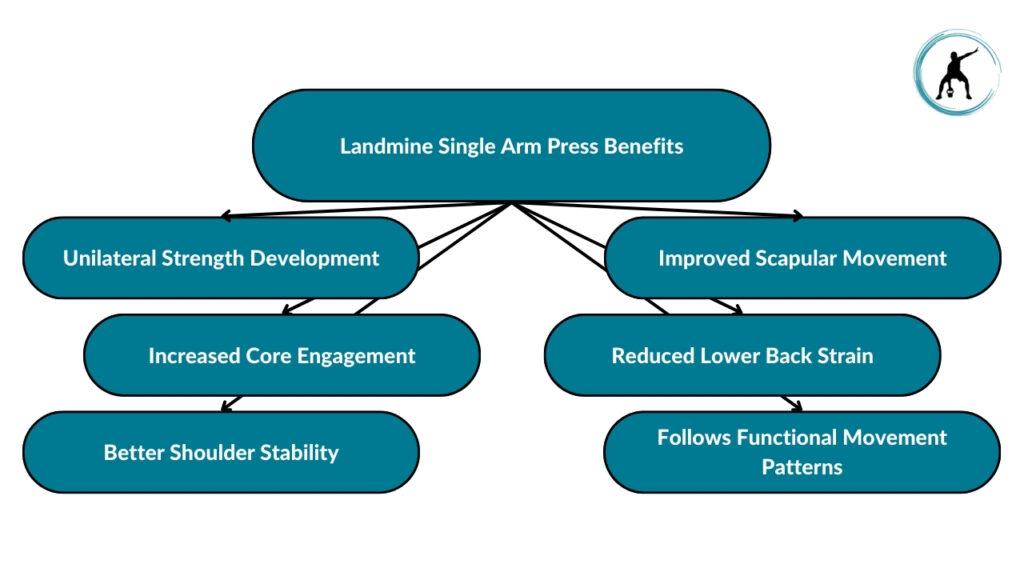
Unilateral Strength Development
This exercise works one side of your body at a time, helping to correct muscular imbalances and increase unilateral strength, which is crucial for functional movements and daily activities.
Also, if you injured one side of your body and can’t exercise it effectively, here is something that may interest you:
A study from PubMed Central found that optimizing for contralateral strength improvements requires that cross-training sessions involve fast eccentric sets with moderate volumes and rest intervals [1]. This means you can still exercise the non-injured side with specific programming to induce positive effects on the injured side.
Increased Core Engagement
Performing the press with one arm requires significant core stability. This engagement strengthens your abdominal and lower back muscles, enhancing overall core strength and stability.
I found it especially useful with clients who lack dynamic stability. This is also what I call functional strength, or more precisely, usable strength. There isn’t much sense in being overly strong if you can’t reproduce it in the majority of circumstances.
Better Shoulder Stability
The unique angle of the landmine press promotes shoulder health by allowing a more natural movement pattern, reducing stress on the shoulder joint, and improving stability.
It allows for a better range of motion, allowing for natural/functional movement patterns to occur. However, there are plenty of other functional shoulder exercises you can implement if you experience problems with your shoulder joints or simply want to increase your strength and mobility.
Improved Scapular Movement
Unilateral landmine press encourages proper scapular movement and stability. This is also essential for shoulder health and upper body functional strength and mobility.
Reduced Lower Back Strain
Compared to traditional overhead presses, the unilateral landmine press places less strain on the lower back, making it a safer alternative for those with back concerns. However, this doesn’t mean you should stop doing military presses and completely substitute it with the single-arm landmine press.
Follows Functional Movement Patterns
The landmine press mirrors real-world functional movement patterns, enhancing functional strength that translates into everyday activities and other sports. This is crucial for just about any athlete and individuals looking to reproduce the same levels of strength in multiple scenarios.
This is also why I encourage people to perform exercises with free weights regularly. Free weights are more functional in nature and will require greater activation of stabilizer muscles.
Are There Any Drawbacks to Performing a Landmine Single-Arm Press With a Barbell?
Some drawbacks to performing a landmine single-arm press with a barbell are occasionally straining your wrist, a higher learning curve, and equipment availability.
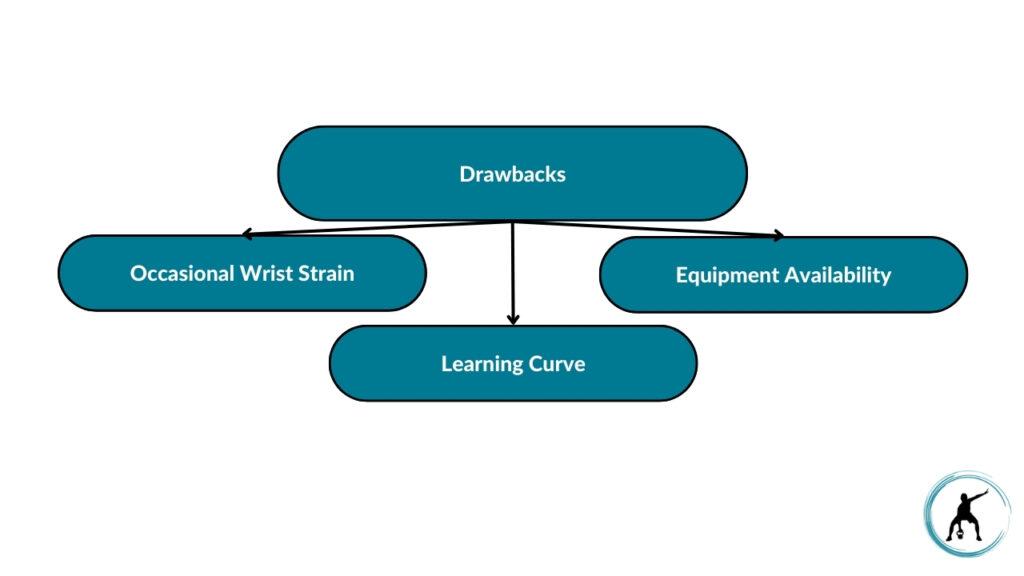
Let’s tackle each of these below.
Occasional Wrist Strain
Due to the fixed nature of the barbell, some individuals might experience wrist strain or discomfort, especially if they have pre-existing wrist issues or if the grip is not properly aligned.
To alleviate wrist strain, consider using wrist wraps for support or adjust your grip slightly. Practice gripping the bar in a way that keeps your wrist in a neutral position. Improving your grip strength with functional forearm exercises can also help alleviate wrist strain.
Learning Curve
The landmine press requires proper technique to be effective and safe. Beginners may find it challenging to maintain form, particularly in terms of shoulder and core stability.
My advice is to start with lighter weights and focus on mastering the technique. Consider working with a trainer who can provide feedback and guidance on proper form.
Equipment Availability
Not all gyms are equipped with a landmine attachment, and setting up an improvised landmine station may not always be feasible or as effective. If a landmine attachment isn’t available, you can still use a cropped DIY tennis ball and place it in the corten.
Alternatively, you can perform exercises like single-arm dumbbells or kettlebell presses that offer similar benefits. These can be done at home or in a gym without specialized equipment.
What Are the Best Tips for Performing a Landmine Single Arm Press?
The best tips for performing a landmine single-arm press are securely anchoring the barbell in the landmine attachment, avoiding excessive forward lean, incorporating proper breathing, and progressing gradually with external resistance.
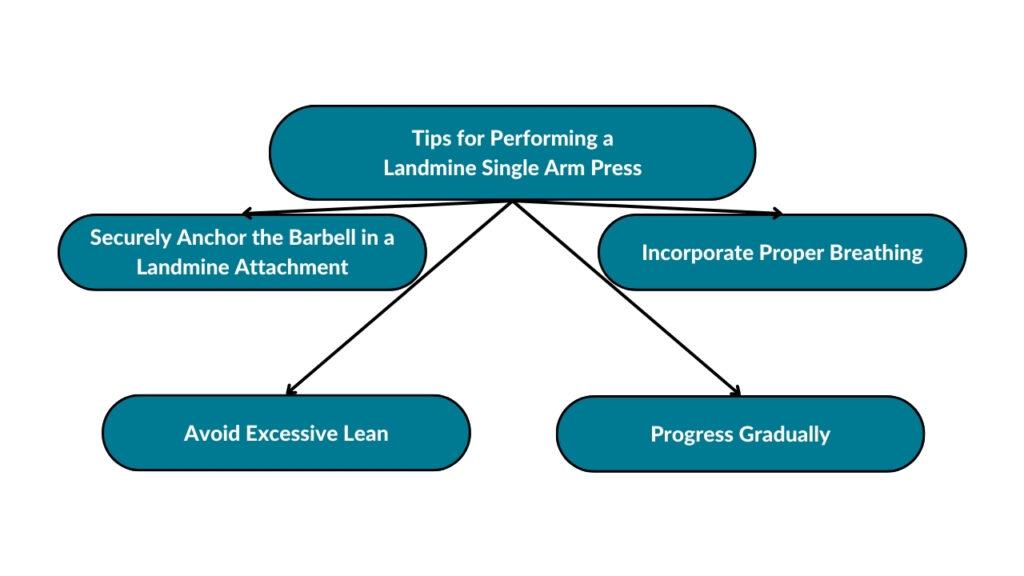
Let’s cover each of these below.
Securely Anchor the Barbell in a Landmine Attachment
Ensuring the barbell is securely anchored is crucial for safety. If you’re using an improvised setup, double-check that it’s stable and won’t shift during the exercise. An unstable barbell can lead to inconsistent movement patterns, increasing the risk of injury.
Avoid Excessive Lean
While some forward lean is natural, excessive leaning can put undue stress on your lower back and reduce the effectiveness of the exercise. Aim to keep your spine in a neutral position and engage your core to maintain balance. This controlled posture ensures that the target muscles are effectively engaged.
Incorporate Proper Breathing
Breathing correctly can significantly impact your performance. Inhale as you lower the weight and exhale forcefully as you press upwards, helping to stabilize your core and maintain rhythm.
Proper breathing not only aids in maintaining a strong core but also helps in pacing your movements and preserving energy throughout the set.
Progress Gradually
Like any exercise, gradual progression is key. Start with lighter weights and increase only when you can perform the exercise in perfect form. This approach helps in building strength sustainably and reduces the risk of injury. It’s also important to listen to your body and not rush the process, as this can lead to overtraining or strain.
According to the study from PubMed Central titled “Diagnosis and prevention of overtraining syndrome: an opinion on education strategies” suggests that there are three phases to consider when diagnosing overtraining syndrome [2]:
- Functional overreaching phase – Performance decrement is noticeable for days/weeks, but the outcome is positive (supercompensation).
- Nonfunctional overreaching phase – Performance decrement noticeable for weeks/months, and the outcome is negative (loss of training time)
- Overtraining syndrome – Performance decrement noticeable for more than a month, and the outcome is negative (possible end to athletic career)
What Are the Most Common Mistakes During a Unilateral Landmine Shoulder Press?
The most common mistakes during a unilateral landmine shoulder press are poor core stability, excessive lateral lean, incomplete range of motion, elbow flaring, and inadequate scapular movement.

Let’s tackle each of these common mistakes below.
Poor Core Stability
Neglecting core engagement can lead to an unstable base, reducing the effectiveness of the press and increasing the risk of injury. Focus on tightening your abdominal muscles throughout the exercise to provide necessary support and stability. In my early days of training, I often overlooked core engagement during this exercise.
This oversight led to less effective workouts and slower progress. Once I started actively engaging my core, I noticed a significant improvement in stability and power during the press.
Excessive Lateral Lean
Leaning too far to one side can compromise your form and place unnecessary strain on your spine. Aim to maintain a straight, upright posture, allowing your core and shoulder muscles to do the work.
Incomplete Range of Motion
Failing to extend your arm at the top of the press fully or not returning to a complete start position can limit the exercise’s effectiveness. Ensure full extension for optimal muscle engagement and development.
Elbow Flaring
Allowing your elbow to flare out to the side can shift the focus away from the target muscles and increase shoulder strain. Keep your elbow in line with your body for a more focused and safer press.
One of my clients struggled with elbow flaring, which led to reduced effectiveness and shoulder discomfort. After correcting this by keeping the elbow aligned, they experienced a noticeable increase in shoulder engagement and comfort.
Inadequate Scapular Movement
Proper scapular movement is essential for shoulder health. Avoid keeping your shoulder blades too rigid. Instead, allow them to move naturally with the press for a full range of motion and muscle activation.
Landmine Single Arm Press Variations
Here are some of the best landmine single arm press variations to consider.
Single-Arm Landmine Press With Rotation
This unilateral landmine press variation incorporates rotational movement, engaging your core and obliques more intensely.

Steps:
- Start in the same position as the standard landmine press.
- As you press the barbell up, rotate your torso toward the pressing arm.
- Keep your feet firmly planted and rotate from your waist.
- Extend your arm fully at the top of the press.
- Return to the starting position while reversing the rotation.
Pro Tip: Focus on initiating the rotation from your core, not just your shoulders. This ensures a full-body engagement and enhances rotational strength.
Half-Kneeling Landmine Single Arm Press
The half-kneeling position increases core stability demands and emphasizes proper hip alignment.
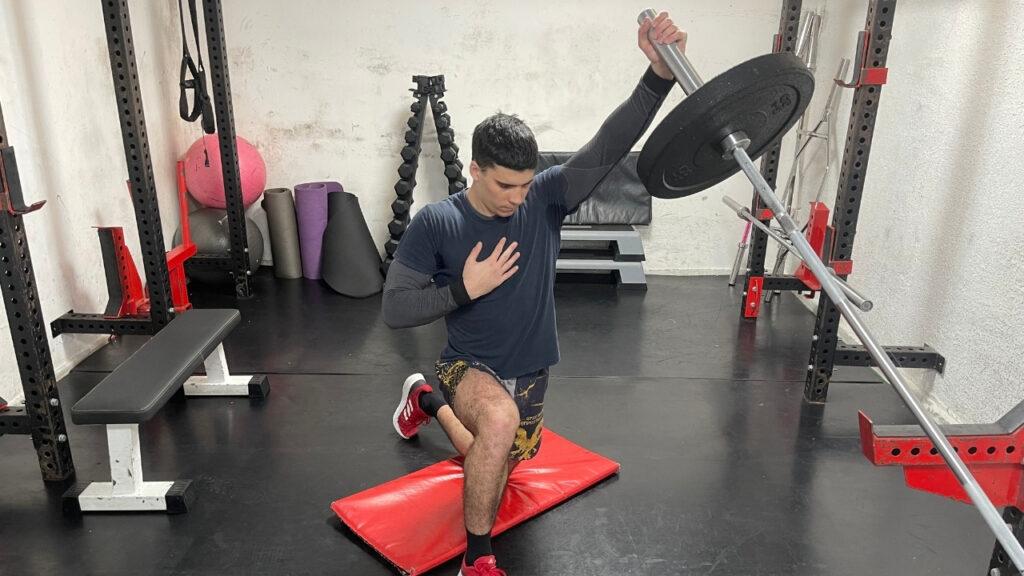
Steps:
- Assume a half-kneeling position with one leg forward and the other knee on the ground.
- Hold the barbell with your hand opposite to the forward knee.
- Press the barbell overhead while maintaining a straight line from your knee to your shoulders.
- Keep your core musculature engaged and hips square to the front.
- Lower the bar back to the height of your shoulders and repeat the whole process again.
Pro Tip: Ensure your forward knee is directly over your ankle during the press. This helps maintain balance and promotes proper alignment throughout the exercise.
Push Press With Landmine
The push press variation adds a lower-body dynamic, making it a more explosive, full-body movement.

Steps:
- Assume the starting standing position, holding the barbell at shoulder height.
- Bend your knees slightly, then quickly extend them, using the momentum to help press the barbell overhead.
- Extend your arm fully at the top, using your shoulder and arm strength.
- Lower the barbell back to the starting position in a controlled manner.
- Repeat the movement, maintaining a rhythmic and explosive pattern.
Pro Tip: Coordinate your leg drive with your arm press for a fluid motion. The leg drive gives the initial push, and the arms complete the movement, enhancing the power of the press.
Landmine Single Arm Press Alternative Exercises
Also, here are additional landmine single arm press alternatives to consider adding to your push workouts.
Half Kneeling Single Arm Kettlebell Press
This exercise focuses on shoulder and core stability, similar to the landmine press, but with a different equipment approach.
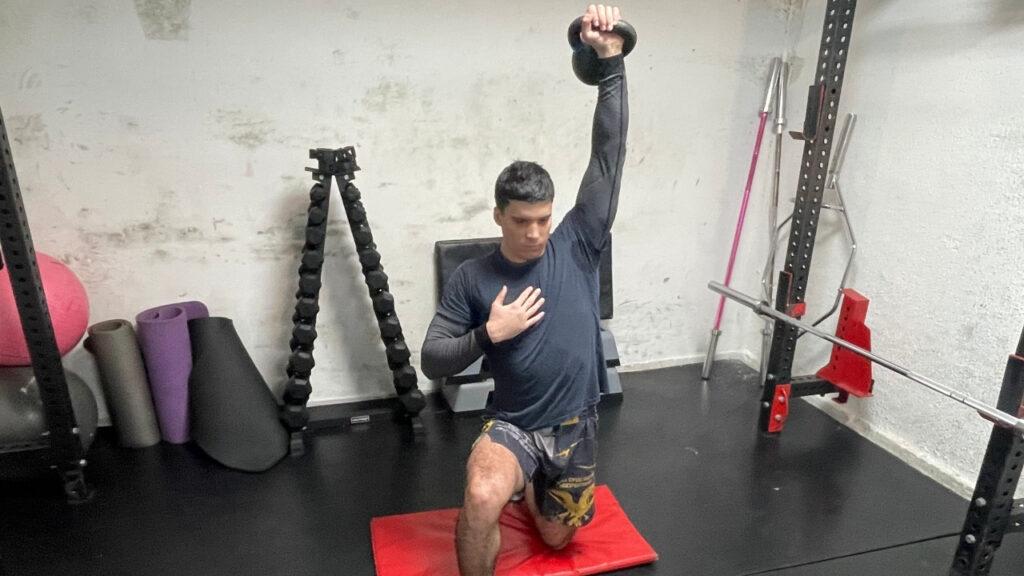
Steps:
- Kneel with one leg forward, creating a 90-degree angle at both knees.
- Hold a kettlebell at shoulder height with the arm opposite your forward leg.
- Press the kettlebell overhead, keeping your wrist straight and core engaged.
- Lower it back to shoulder height in a controlled manner.
- Repeat for the desired number of reps before switching sides.
Pro Tip: Keep your gaze forward and your spine neutral throughout the movement. This helps maintain proper posture and focus on the shoulder and core engagement.
Half Kneeling Single Arm Dumbbell Press
The dumbbell press in a half-kneeling position allows for more freedom of movement compared to the landmine press, challenging stability differently.
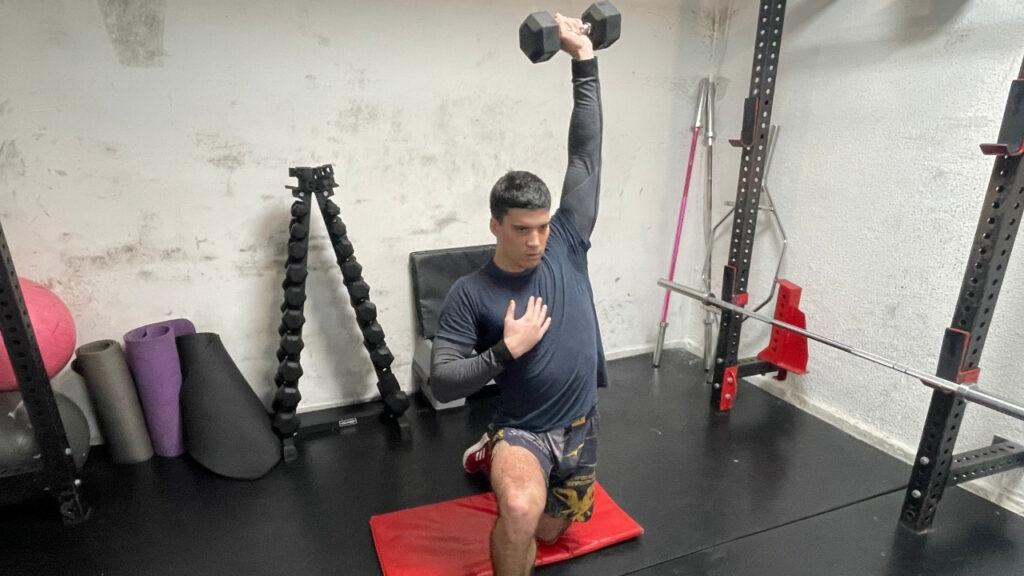
Steps:
- In a half-kneeling position, hold a dumbbell at shoulder height with the palm facing forward.
- Press the dumbbell upward until your arm is fully extended.
- Ensure your core is braced and your glutes are engaged to maintain stability.
- Lower the dumbbell back to the starting position with control.
- Complete the set before switching to the other arm.
Pro Tip: Align your pressing hand with the center of your head at the top of the press. This alignment engages the shoulder muscles effectively while maintaining balance.
Half-Kneeling Single Arm Arnold Press
The Arnold press adds a rotational element to the standard press, targeting the shoulder muscles through a greater range of motion.
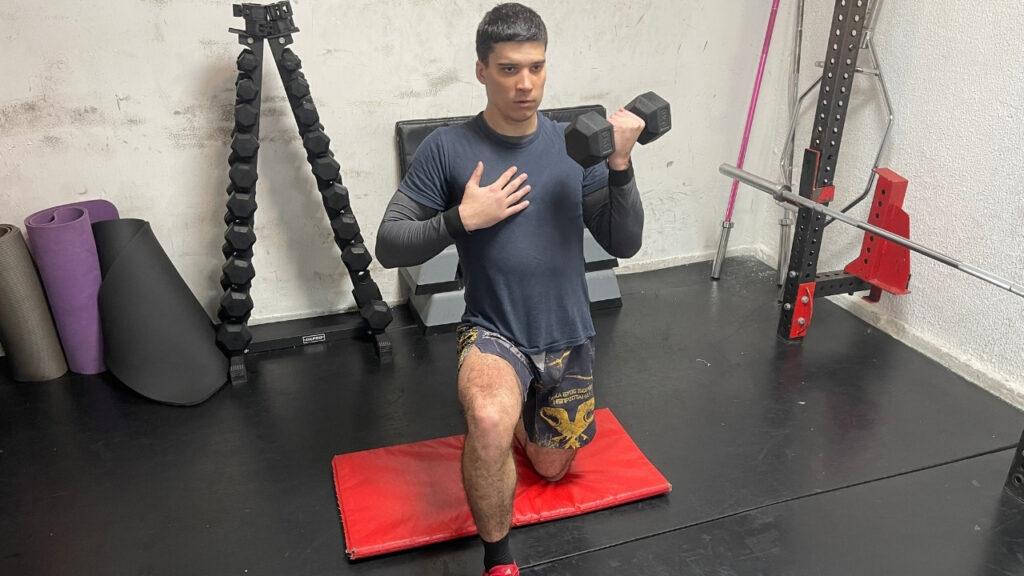
Steps:
- Begin in a half-kneeling position, holding a dumbbell in front of your shoulder, palm facing you.
- As you press the dumbbell overhead, rotate your arm so your palm faces forward at the top.
- Keep your core tight and back straight throughout the movement.
- Reverse the motion to return to the starting position.
- Repeat the sequence, maintaining a smooth and controlled movement.
Pro Tip: The rotation should be smooth and synchronized with the pressing movement. This combination enhances shoulder mobility and muscle engagement.
FAQs
What Muscles Does the Single Arm Landmine Press Work?
The single arm landmine press primarily works the shoulders, chest, and triceps. This exercise targets these muscles by engaging them in a pressing motion, which is beneficial for upper body strength and stability.
Is Landmine Press Worth It?
The landmine press is worth it for those seeking a versatile and joint-friendly upper-body exercise. It offers a unique angle and range of motion that can enhance strength and muscle engagement differently from traditional presses.
Can You Build Muscle With Landmine?
You can build muscle with landmine exercises as they effectively target various muscle groups. The versatility of landmine workouts allows for a range of movements that can stimulate muscle growth and strength.
How Heavy Should Landmine Press Be?
The weight for the landmine press should be challenging yet manageable, typically ranging from moderate to heavy based on individual strength levels. It’s important to choose a weight that allows for proper form and full range of motion throughout the exercise.
Where Should You Feel Landmine Press?
You should feel the landmine press primarily in your shoulders, chest, and triceps. These muscles are actively engaged during the pressing motion, indicating effective targeting and execution of the exercise.
Does Landmine Press Increase Punching Power?
The landmine press can increase punching power by strengthening the shoulders, chest, and triceps. This exercise improves upper body strength and explosive power, which are crucial for enhancing punching ability.
Do You Really Need a Landmine Attachment?
A landmine attachment is not absolutely necessary but is highly beneficial for performing landmine exercises safely and effectively. It provides stability and a specific angle for the barbell, enhancing the exercise’s effectiveness and reducing the risk of injury.
What Size Barbell Is Best for Landmine?
The best size barbell for landmines is typically a standard Olympic barbell, which is 7 feet long and fits well in most landmine attachments. This size allows for optimal range of motion and stability during Landmine exercises.
Wrapping Up
The landmine single-arm press is a multifaceted exercise that offers significant benefits for strength, stability, and functional fitness. Its ability to work multiple muscle groups, including the shoulders, chest, and triceps, makes it a valuable addition to any workout regimen.
Whether you’re an athlete, fitness enthusiast, or someone looking to enhance your physical capabilities, incorporating this exercise can lead to improved unilateral strength, core stability, and overall functional movement.
Remember to focus on proper form and technique and consider the variations and alternatives provided to keep your workouts diverse and effective.
Start Building Your Dream Body Today
Ready to elevate your fitness game without falling into the trap of dull, repetitive routines that just don’t deliver? Imagine sculpting your ideal physique and boosting your health, all while still enjoying life’s pleasures, like those irresistible weekend getaways and your aunt’s legendary cheesecake. With our online fitness and nutrition coaching service, you don’t have to compromise. Dive into a personalized fitness journey that blends perfectly with your lifestyle, not against it. Book your completely free discovery consultation today, and take the first step towards a transformation that doesn’t require giving up the joys of life.

“I was skeptical about online fitness coaching, but Functional Body Savage completely changed my perspective. Vanja and Radomir’s personalized approach and attention to detail have helped me achieve goals I never thought possible. I’m stronger, more confident, and grateful for their guidance.”
Emily Thompson, San Francisco, CA
Learn More About Our Online Coaching ServiceReferences:
- Cirer-Sastre R, Beltrán-Garrido JV, Corbi F. Contralateral Effects After Unilateral Strength Training: A Meta-Analysis Comparing Training Loads. J Sports Sci Med. 2017;16(2):180-186. Published 2017 Jun 1.
- Kreher JB. Diagnosis and prevention of overtraining syndrome: an opinion on education strategies. Open Access J Sports Med. 2016;7:115-122. Published 2016 Sep 8. doi:10.2147/OAJSM.S91657

